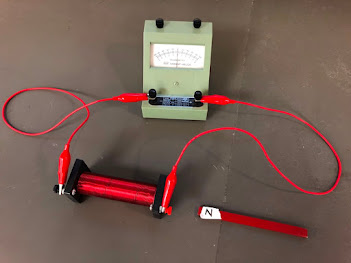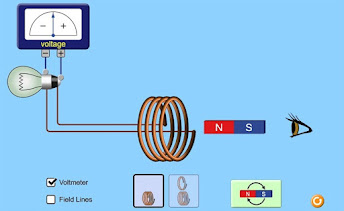Previous posts:
My favorite web applications - Part 1
My favorite web applications - Part 2
My favorite web applications - Part 3
Of course, I have to include a PhET application. How could I not? It is such an amazing collection of very useful applications and simulations.
For this one it is the demonstration on Faraday's/Lenz's law. What is interesting about this is that, if you have read one of my previous posts, I use this not so much as a virtual lab, but rather as an in-class "discovery" tool. In fact, for my f2f classes, I had an identical setup to this PhET application sitting in front of the students at the beginning of class. So the instruction that you'll see given to the students is almost identical for this application and for in-class activity.
This obviously is a lesson on Lenz's law. Instead of starting the lesson with a lecture, I give the students a series of tasks for them to do. I first tell them to set up the application or in-class apparatus to look like the picture below:
We then spend some time discussing the direction of the current in the coil if the galvanometer (in-person) or the voltmeter (PhET) has a positive or negative deflection based on being observed from the right side of the coil.
Once the students have established this, I give them a series of tasks that they have to perform and to record what they observe. The tasks are listed in the table below:
When we were doing this in-person, I asked the students to perform Task 1, to record what they observed, and then we all, as a class, discuss the observation. This exercise was helpful especially to students who were still unsure on what to do and what they should be observing. So this first tasks often clarified further what they needed to perform and what they should observe. For remote classes, this is not that easy mainly because I don't quite see what they students are doing and what they are observing. They are also doing this in their separate Zoom breakout rooms. They have a chance to discuss with members of their group, but I am not always there to double-check what they are observing. I do, however, get to see what they are recording because the table above is posted on a Google Slide document that I give them. So I can see every entry for each group and able to step in if I see something not quite right.
In any case, the students for in-person session perform the task one step at a time, and each time, we all discuss the observation. Remember that I have not told them anything about Lenz's law at all. All they are doing at this stage is performing a task and recording the corresponding observation.
By the end of this activity, both the in-person and remote students will have a set of observations for each of the tasks performed. This is where it gets interesting. I then instruct the students to discuss with their group members on how to come up with a set of rules or "laws" to accurately describe the behavior of the current in the coil in relation to what the bar magnet is doing. In other words, I want the to come up with a written description of Lenz's law.
Of course, I give them hints. The biggest hint is for them to consider the induced magnetic field in the coil. By that point, they have learned that a current in a coil or solenoid generates a magnetic field. If there is a deflection in the galvanometer/voltmeter, then there must be a current in the coil. The positive or negative deflection indicates the direction of the current in the coil, which in turn indicates the direction of the induced magnetic field in the coil.
From my experience in doing this for several semesters, only about 1/4 of the students were able to come up with a description that had a close resemblance to Lenz's law. Many of them struggled not just in understanding what they observed and what the "laws" were, but also in communicating accurately and clearly what they intended to say. The latter is a very common problem for many students trying to write scientific prose.
However, regardless of whether they managed to successfully come up with their own version of Lenz's law, I find that this exercise demonstrates this principle a lot clearer than if I just simply spew out the material in a lecture. Even if the students could not communicate clearly what they understood, most of them actually had some realization of what it is. To me, this is the biggest stumbling block in understanding Lenz's law, which was the impetus for me to present this topic in this manner.
The PhET application allowed me to do almost the same activity online as the one I do in-person. That is a very good thing!
Zz.



